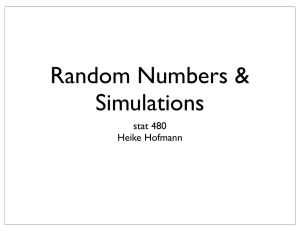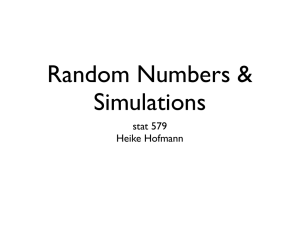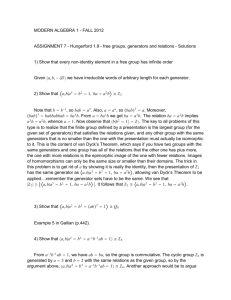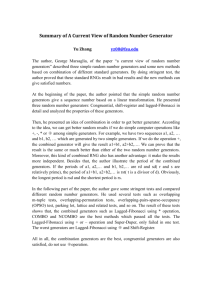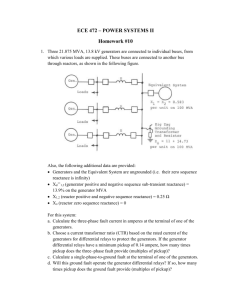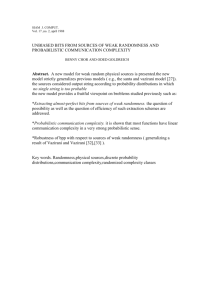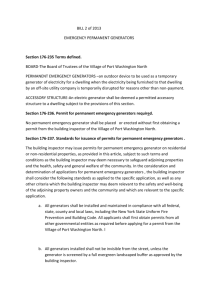Lecture Notes to Accompany Scientific Computing An Introductory
advertisement
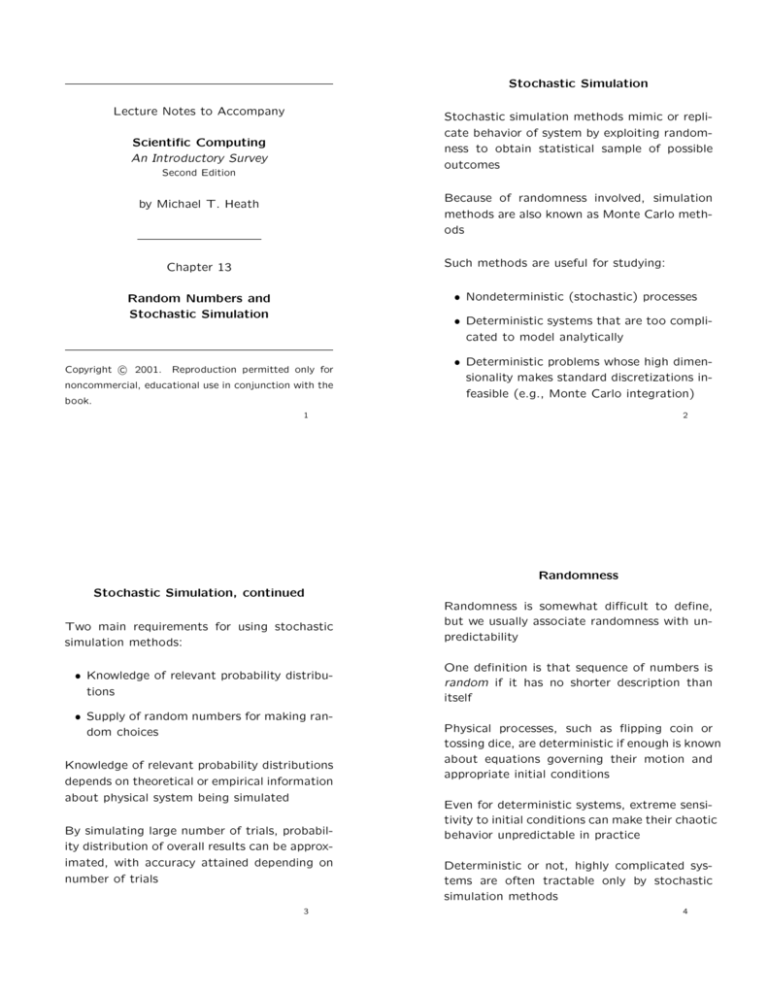
Stochastic Simulation Lecture Notes to Accompany Stochastic simulation methods mimic or replicate behavior of system by exploiting randomness to obtain statistical sample of possible outcomes Scientific Computing An Introductory Survey Second Edition Because of randomness involved, simulation methods are also known as Monte Carlo methods by Michael T. Heath Such methods are useful for studying: Chapter 13 • Nondeterministic (stochastic) processes Random Numbers and Stochastic Simulation c 2001. Copyright • Deterministic systems that are too complicated to model analytically Reproduction permitted only for noncommercial, educational use in conjunction with the book. • Deterministic problems whose high dimensionality makes standard discretizations infeasible (e.g., Monte Carlo integration) 1 2 Randomness Stochastic Simulation, continued Two main requirements for using stochastic simulation methods: • Knowledge of relevant probability distributions • Supply of random numbers for making random choices Knowledge of relevant probability distributions depends on theoretical or empirical information about physical system being simulated By simulating large number of trials, probability distribution of overall results can be approximated, with accuracy attained depending on number of trials 3 Randomness is somewhat difficult to define, but we usually associate randomness with unpredictability One definition is that sequence of numbers is random if it has no shorter description than itself Physical processes, such as flipping coin or tossing dice, are deterministic if enough is known about equations governing their motion and appropriate initial conditions Even for deterministic systems, extreme sensitivity to initial conditions can make their chaotic behavior unpredictable in practice Deterministic or not, highly complicated systems are often tractable only by stochastic simulation methods 4 Pseudorandom Numbers Although random numbers were once supplied by physical processes or tables, they are now produced by computers Repeatability In addition to unpredictability, another distinguishing characteristic of true randomness is lack of repeatability Computer algorithms for generating random numbers are in fact deterministic, although sequence generated may appear random in that it exhibits no apparent pattern However, lack of repeatability could make testing algorithms or debugging computer programs difficult, if not impossible Such sequences of numbers are more accurately called pseudorandom Repeatability is desirable in this sense, but one must take care to ensure that independence is maintained among trials Although pseudorandom sequence may appear random, it is in fact quite predictable and reproducible, which is important for debugging and verifying results Because only finite number of numbers can be represented in computer, any sequence must eventually repeat 5 6 Random Number Generators A good random number generator should have as many of following properties as possible • Random pattern: passes statistical tests of randomness • Long period: goes as long as possible before repeating • Efficiency : executes rapidly and requires little storage • Repeatability : produces same sequence if started with same initial conditions • Portability : runs on different kinds of computers and is capable of producing same sequence on each 7 Random Number Generators, cont. Early attempts at producing random number generators on computers often relied on very complicated procedures, whose very complexity was felt to ensure randomness Example is “midsquare” method, which squares each member of sequence and takes middle portion of result as next member of sequence Lack of theoretical understanding of such methods proved disastrous, and it was soon recognized that simple methods with well-understood theoretical basis are far preferable 8 Congruential Generators Congruential Generators, cont. Congruential random number generators have form It is possible to obtain reasonably good random number generator using this method, but values of a and c must be chosen very carefully xk = (axk−1 + c)(modM ), where a and c are given integers Starting integer x0 is called seed Many system-supplied random number generators are of congruential type, and some of them are notoriously poor Integer M is approximately (often equal to) largest integer representable on machine Congruential generator produces random integers between 0 and M Quality of such generator depends on choices of a and c, and in any case its period cannot exceed M To produce random floating-point numbers, say uniformly distributed on interval [0, 1), random integers must be divided by M 9 10 Fibonacci Generators Alternative methods that produce floating-point random numbers on interval [0, 1) directly are Fibonacci generators, which generate new value as difference, sum, or product of previous values Fibonacci Generators, cont. Fibonacci generators require more storage than congruential generator, and also require special procedure to get started Fibonacci generators require no division to produce floating-point results Typical example is subtractive generator xk = xk−17 − xk−5 Well-designed Fibonacci generators have very good statistical properties This generator has lags of 17 and 5 Lags must be chosen carefully to produce good subtractive generator Such formula may produce negative result, in which case remedy is to add 1 to get back into interval [0, 1) 11 Fibonacci generators can have much longer period than congruential generators, since repetition of one member of sequence does not entail that all subsequent members will also repeat in same order 12 Nonuniform Distributions More difficult problem is to sample from nonuniform distributions Sampling on Other Intervals If we need uniform distribution on some other interval [a, b), then we can modify values xk generated on [0, 1) by transformation If cumulative distribution function of desired probability density function is easily invertible, then we can generate random samples with desired distribution by generating uniform random numbers and inverting them For example, to sample from exponential distribution (b − a)xk + a f (t) = λe−λt, to obtain random numbers that are uniformly distributed on desired interval t > 0, we can take xk = − log(1 − yk )/λ, where yk is uniform on [0, 1) Unfortunately, many important distributions are not easily invertible, and special methods must be employed to generate random numbers efficiently for these distributions 13 14 Quasi-Random Sequences Normal Distribution Important example is generation of random numbers that are normally distributed with given mean and variance Available routines often assume mean of 0 and variance of 1 σ2 If some other mean µ and variance are desired, then each value xk produced by routine can be modified by transformation σxk + µ to achieve desired normal distribution For some applications, achieving reasonably uniform coverage of sampled volume can be more important than whether sample points are truly random Truly random sequences tend to exhibit random clumping, leading to uneven coverage of sampled volume for given number of points Perfectly uniform coverage can be achieved by using regular grid of sample points, but this approach does not scale well to higher dimensions Compromise between these extremes of coverage and randomness is provided by quasirandom sequences 15 16 Quasi-Random Sequences, cont. Such sequences are not random at all but are carefully constructed to give uniform coverage of sampled volume while maintaining reasonably random appearance By design, points tend to avoid each other, so clumping associated with true randomness is eliminated .................................................................... ........................ ........................ ...................... ...................... ........................ ...................... ...................... ........................ ...................... ....................... ...................... ...................... ........................ ...................... ...................... ...................... ...................... ......................... ........................ ................................................................ Grid ............................................................................................... ....... ..... .. ..... . ... ... ..... .. .. . ... ................................... ......................... ..... .. . ..... ........... ... ... ........ ..... .... ... . .... ......... .......................... ............ ........... .. ....... . .... ... ....... .... ...... . ..... . ... ... .... . ..... ...... ... ... .... ................................................................................... Random ................................................................... .......................... ...... ................. . .. . . . ........................................................... .... .... .. .. ... ... . .... ..... ...... ........... ............... .... ......... ........... .. .. .... ..... . ......... . .. .... ........ ............. .. .......... ...... ....... .. ......... ........... ... .... .... . .. ........... .. . .... ...... ............... ...... .... ...................................................................................... Quasi-random 17

